Budget Blunder: “No Cuts” in Nuclear Forces
 |
| The new defense budget has “no cuts” in nuclear forces. |
.
By Hans M. Kristensen
“There are no cuts made in the nuclear force in this budget.” That clear statement was made yesterday by deputy defense secretary Ashton Carter during the Pentagon’s briefing on the defense budget request for Fiscal Year 2013.
We’ll have to see what’s hidden in the budget documents once they are released next month, but the statement is disappointing for anyone who had hopes that the administration’s promises about “concrete steps” to reduce the number and role of nuclear weapons and to “put an end to Cold War thinking” would actually be reflected in the new defense budget.
Not so for the FY13 budget. Other than a decision to delay work for two years on the next generation ballistic missile submarine, the Defense Budget Priorities and Choices report released yesterday does not list any nuclear reductions; neither previously announced nor new ones.
But one year after the New START treaty entered into effect and 18 months after the Nuclear Posture Review was completed, it would have made sense to include some nuclear cuts in this budget – especially because this budget includes programming for future budget years through 2017, only one year before the New START treaty has to be implemented. Specifically, the Pentagon should have explained how (and how soon) it will achieve the previously announced plans to:
- Reduce the number of nuclear bombers to 60 deployed aircraft;
- Reduce the number of ICBMs to no more than 420 deployed missiles;
- Reduce the number of SLBMs to no more than 240 deployed missiles;
- Retire the nuclear Tomahawk cruise missile.
Why wait? Demonstrating that the U.S. is not only talking about reducing its nuclear forces but also doing so through near term defense budget cuts would have been an important signal to other nuclear weapon states whose militaries are waiting to see what has changed in the U.S. nuclear posture. It would also have been an important signal to the countries in the international nuclear nonproliferation regime that will convene in May to prepare for the next review of the nuclear Non-Proliferation Treaty, countries whose support we need to strengthen the nonproliferation regime.
Instead, the administration might now have to spend a good part of the next year saying: “Trust us, we’re working on it.”
And it is working on it. The most important effort is the review currently underway within the administration of the requirements for targeting and alert levels of nuclear forces – requirements that determine the force level. The review may well decide additional reductions beyond New START.
In a hint to what might come, the new defense strategic guidance published in early January stated: “It is possible that our deterrence goals can be achieved with a smaller nuclear force, which would reduce the number of nuclear weapons in our inventory as well as their role in U.S. national security strategy.” (Emphasis in original.)
The Defense Budget Priorities and Choices document appears to reaffirm this by stating that the White House review “will address the potential for maintaining our deterrent with a different nuclear force.”
Once the deterrence review is completed, it is important that the White House explains to the world what it has decided and doesn’t leave it to leaks and vague comments by anonymous officials to determine what the international perception of the direction of the U.S. nuclear posture will be.
This publication was made possible by a grant from Carnegie Corporation of New York and Ploughshares Fund. The statements made and views expressed are solely the responsibility of the author.
US Releases Full New START Data
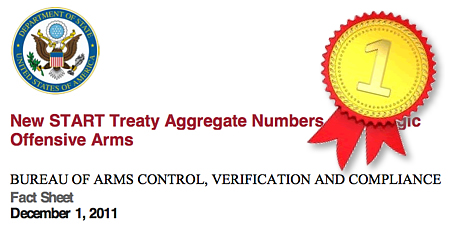 |
| The Obama administration gets a medal for disclosing its New START treaty numbers. |
.
By Hans M. Kristensen [updated 12 Dec 2011 with new bomber information]
Anyone familiar with my writings knows that I don’t hand out medals to the nuclear weapon states very often. But the Obama administration deserves one after the U.S. State Department’s recent release of the full U.S. aggregate data under the New START treaty.
The release breaks with the initial practice under the treaty of only publishing overall nuclear force category numbers, and re-establishes the U.S. practice from the previous START treaty of providing maximum disclosure of the strategic forces counted by the treaty. This is a good development that has gone totally unnoticed in the news media.
The pressure is now squarely on Russia to follow suit and publish its New START aggregate data as well.
Overall Posture
The New START data attributes 1,790 warheads to 822 deployed ICBMs, SLBMs, and heavy bombers as of September 1, 2011. A large number of non-deployed missiles and launchers that could be deployed are not attributed warheads.
The data shows that the United States will have to eliminate 243 launchers over the next six years to be in compliance with the treaty by 2018. Fifty-six of these will come from reducing the number of launch tubes per SSBN from 24 to 20, roughly 80 from stripping B-52Gs and nearly half of the B-52Hs of their nuclear capability, and destruction of 100 ICBM launchers.

The released data does not contain a breakdown of how the 1,790 deployed warheads are distributed across the three legs of the Triad. But because the bomber number is now disclosed (each bomber counts as one warhead) and because roughly 500 warheads remain on the ICBMs, it is possible to make an estimate of the number of warheads deployed on the ballistic missile submarines: approximately 1,200 warheads, or two-thirds of the total count under New START.
Ballistic Missile Submarines
The New START data shows that the United States as of September 1, 2011, had 249 Trident II SLBMs onboard its SSBN fleet. Each SSBN has 24 missile tubes for a maximum loadout of 288 missiles, but at the time of the New START count three SSBNs were empty and one partially loaded. With an estimated 1,200 warheads on the SLBMs, that translates to an average of 4-5 warheads per missile.
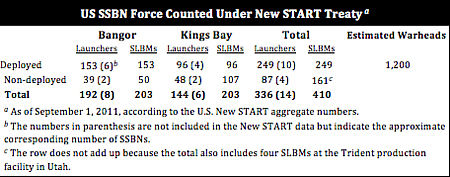
The assumption is normally that 12 out of 14 SSBNs are deployed, with the remaining two in overhaul at any given time. But the New START data illustrates that the force ready for deployment sometimes is smaller, in this case only 10 SSBNs. Other information shows that this ratio fluctuates significantly, and in average 64 percent (8-9) of the SSBNs are at sea with roughly 920 warheads. Up to five of those subs are on alert with 120 missiles carrying an estimated 540 warheads. That’s enough to obliterate every major city on the face of the earth.
The SSBN fleet conducted 33 deterrent patrols last year, with each operational SSBN sailing on three patrols per year, each lasing 70-100 days. That’s a very high operational tempo, comparable to that of the Cold War.
The bulk of the SSBN fleet is based at Bangor (Kitsap) Submarine Base in Washington. Eight subs are homeported at this base, and the New START data shows that two were out of commission on September 11, 2011: one had empty missile tubes – possibly because it was in dry dock – and another was only partially loaded – possibly because it was in the middle of a missile exchange when the count occurred. This means that six of eight SSBNs at the base were loaded with Trident II D5 missiles at the time of the New START count.
A satellite image taken on August 20, 2011, only 11 days before the New START data count, shows three Ohio-class subs present at Bangor, including one in dry dock and another at the Explosives Handling Wharf. (see figure below).
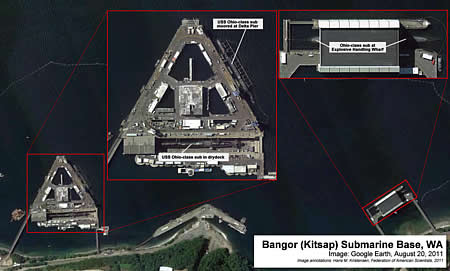 |
| Three SSBNs were present at Bangor Submarine Base on August 20, shortly before the New START count. Click on image for full size. |
.
The same image also shows two Ohio-class subs at Puget Sound Naval Shipyard at Bremerton, Washington, only a few miles away. One of the two is an SSGN, a former SSBN stripped of its nuclear missiles and converted to carry cruise missiles and special forces. The other appears to be an SSBN. The New START data does not reflect two entirely empty SSBNs on the west coast, so either one of them was loaded with missiles between the time of the satellite image and the New START count, or the SSBN at Puget Sound Naval Shipyard is from Kings Bay.
The remaining five Bangor-based SSBNs that were at sea the day the image was taken carried 120 missiles with an estimated 540 warheads. Three of those were on alert with 72 missiles and roughly 325 warheads.
In the Atlantic, six SSBNs are based at Kings Bay Submarine Base in Georgia, a significant change from the Cold War when most U.S. SSBNs were homeported on the east coast. Two of the six subs did not carry missiles on September 1, 2011, leaving a deployable force of four SSBNs carrying 96 missiles with an estimated 430 warheads.
The New START data shows that the U.S. Navy has not yet begun to reduce the number of missile tubes on each SSBN. The Pentagon has stated that the number of missile tubes on each submarine will be reduced from 24 to 20 before the New START enters into force in 2018.
Intercontinental Ballistic Missiles
The New START data shows that the United States deployed 448 Minuteman III ICBMs as of September 1, 2011. Most were at the three launch bases, but a significant number were in storage at maintenance and storage facilities in Utah. That included 58 MX Peacekeeper ICBMs retired in 2003-2005 but which have not been destroyed.

The New START data does not show how many warheads were loaded on the 448 deployed ICBMs, but the number is thought to be approximately 500. The 2010 NPR decided to “de-MIRV” the ICBM force, an unfortunately choice of words because the force will be downloaded to one warhead per missile, but retain the capability to re-MIRV if necessary.
Heavy Bombers [updated 12 Dec 2011 with new B-1 information]
The New START data shows that the U.S. Air Force possessed 152 B-2 and B-52 bombers as of September 1, 2011. Of these, 125 were counted as deployed. The disclosure of the bomber count breakdown is important because it has been unclear how many bombers were actually counted by the treaty. The count includes B-52G bombers that are not used for nuclear missions, but still carry equipment that makes them accountable under the treaty. The last of the B-1s that were still nuclear capable when the treaty was signed were denuclearized in early 2011.
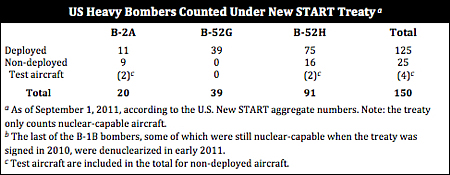
Of the 20 B-2s and 93 B-52s, 18 and 76 (a total of 94), respectively, are nuclear-capable. But only about 60 those are thought to be nuclear tasked at any given time. Stripping excess B-52Hs and the remaining B-52Gs of their nuclear equipment will be necessary to get down to 60 nuclear-capable bombers by 2018.
Heavy bombers do not carry nuclear weapons under normal circumstances, but a few hundred warheads are thought to be stored at the three bomber bases. In addition, hundreds of additional bomber warheads are in central storage. Overall, some 1,000 bombs and cruise missiles are thought to be earmarked for use by the bombers. The NPR states that bombers (along with SSBNs) play an important role in warhead upload scenarios.
Conclusions and Recommendations
The State Department’s release of the full U.S. aggregate data under the New START treaty deserves credit because it increases transparency of U.S. nuclear forces and restores the practice under the previous START treaty of disclosing such information to the public.
After the New START treaty was signed in April 2010 and entered into force in February 2011, it first appeared as if this information would not be released. I warned against this in March, and in May, three former U.S. officials joined FAS in urging the United States and Russia to disclose the full aggregate data.
The first New START aggregate data from February (released in June) did not follow the advice; only six overall numbers were disclosed. The new release of the full September data corrects that mistake.
In context, the data release is extra impressive because it follows the release of other important nuclear information by the United States over the past 18 months, most importantly the disclosure in May last year of the size and history of the total nuclear warhead stockpile and warhead dismantlement.
Following all of this, a clear responsibility now rests on Russia to follow suit and begin to lift the veil for its nuclear arsenal as well. Russia generally discloses very little about its nuclear forces and is falling behind Britain, France, and the United States in transparency. Andrei Nesterenko from the Russian foreign ministry stated in May 2010 that after the New START treaty “comes into force, we will also be able to consider practically the issue of publishing the total amount of deployed strategic carriers and…warheads.”
Well, now the treaty is in force, and with the Preparatory Committee for the nuclear Non-Proliferation Treaty (NPT) – the so-called NPT PREPCOM – coming up in early May 2012, the next few months would be a good time for Russia to follow the U.S. lead and release the full New START aggregate numbers.
After all, if the Kremlin can share this information with the Pentagon, what’s the point in denying it to the rest of the world?
This publication was made possible by a grant from Carnegie Corporation of New York and Ploughshares Fund. The statements made and views expressed are solely the responsibility of the author.
New Article On Obama Administration Nuclear Targeting Review
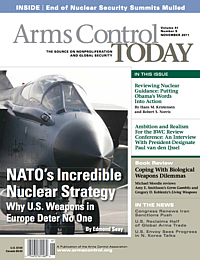 |
| New article published in Arms Control Today |
.
By Hans M. Kristensen
The latest issue of Arms Control Today includes a new article by Robert Norris and myself about the nuclear targeting review that is currently underway in the Obama administration.
In ordering the review, formally known as the Post-NPR Review, President Obama has asked the military to review and revise U.S. nuclear strategy and guidance on the roles and missions of nuclear weapons, including potential changes in targeting requirements and alert postures, in preparation for the next round of nuclear reductions beyond the New START treaty with Russia.
Our article describes the bureaucratic labyrinth the review will go through before new presidential guidance emerges to change the U.S. nuclear war plan. To that end, we offer a wide range of suggestions for how the review could reduce the requirements for U.S. nuclear forces to “put an end to Cold War thinking,” as President Obama said in his Prague speech in 2009.
Note: accessing the article requires subscription to Arms Control Today.
Further information: Obama and the Nuclear War Plan (FAS, 2010).
This publication was made possible by a grant from Carnegie Corporation of New York and Ploughshares Fund. The statements made and views expressed are solely the responsibility of the author.
New START Data: Modest Reductions and Decreased Transparency
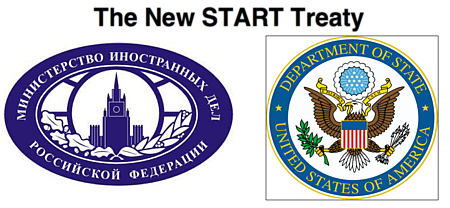 |
| New START aggregate numbers have been published by the United States and Russia. |
.
By Hans M. Kristensen
The latest New START treaty aggregate numbers of strategic arms, which was quietly released by the State Department earlier last week, shows modest reductions and important changes in U.S. and Russian strategic nuclear forces.
Most surprisingly, the data shows that Russia has increased its number of deployed strategic nuclear warheads and is now again above the New START limit.
Because of the limited format of the released aggregate numbers, however, the changes are not explained or apparent. As a result, though not yet one year old, the New START treaty is already beginning to increase uncertainty about the status of U.S. and Russian nuclear forces.
Overall Changes
Combined, the data shows that the United States and Russia as of September 2011 deployed 3,356 nuclear warheads on 1,338 strategic delivery vehicles, down from 3,337 warheads on 1,403 delivery vehicles in February 2011.
A modest combined reduction of 65 delivery vehicles in seven months, but an increase of 19 warheads; apparently they two nuclear superpowers are not in a hurry to reduce.
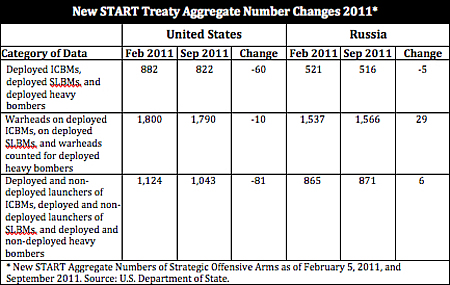 |
| The New START aggregate data shows modest reductions in strategic delivery vehicles and a Russian increase of deployed strategic warheads. |
.
The aggregate numbers not include thousands of additional strategic and non-strategic warheads that are not counted by the treaty. To put things in perspective, the U.S. military stockpile includes nearly 5,000 warheads; the Russian stockpile probably about 8,000. In addition, thousands of retired, but still intact, warheads are in storage for a total combined U.S. and Russian inventory of perhaps 19,000 warheads.
Russia
Most surprising is that the New START data erases Russia’s achievement from earlier this year when its number of deployed strategic warheads temporarily dipped below the treaty limit of 1,550 warheads. According to the new data, Russia has slightly increased (by 29) the number of warheads deployed on its ballistic missiles and now stands 16 warheads above the treaty limit.
The warhead increase comes at the same time that the number of delivery vehicles has declined by five. But since the New START aggregate data – unlike the previous START treaty – does not include a breakdown of missile types, it is impossible to see where the change happened. As a result, transparency of Russia’s strategic nuclear forces is decreasing.
Part of the explanation is the deployment of additional RS-24 ICBMs, which carry three warheads each. But that’s a limited deployment that doesn’t account for all. Other parts of the puzzle include continued reduction of the single-warhead SS-25 ICBM force, the operational status of individual Delta IV SSBNs, and possibly retirement of one of the aging Delta III SSBNs.
The United States
The New START data shows that the United States only removed 10 warheads from its ballistic missiles during the previous seven months, down from 1,800 to 1,790 warheads.
The number of delivery vehicles declined by 60, from 882 to 822, a change that probably reflects the removal of nuclear-capable equipment from so-called “phantom” bombers. These bombers are counted under the treaty even though they are not actually assigned nuclear missions. The U.S. has not disclosed the number, but another 24, or so, “phantom” bombers probably need to be denuclearized. Stripping these aircraft of their leftover equipment reduces the number of nuclear delivery vehicles counted by the treaty, although it doesn’t actually reduce the nuclear force.
Later this decade will come a gradual reduction of the number of SLBMs deployed on SSBNs from 288 to 240. Likewise, if the bomber force is retained, the ICBM force might be reduced to 400 missiles from 450 today.
Conclusions
The New START data shows that Russia and the United States have gotten off to a slow start and excessive nuclear secrecy is reducing the international community’s ability to monitor and analyze the changes.
Russia essentially has seven and half years to offload 16 warheads from its force to be in compliance with New START by 2018. Not an impressive arms control standard. Instead, the task for Russian planners will be how to phase out old missiles and phase in new missiles. There will be no real constraint on the Russian force.
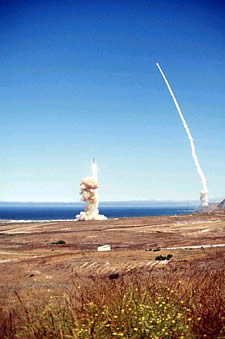 |
| The United States ICBM force could be a big as Russia’s entire triad by the mid-2020s. |
The new data underscores the substantial lead the United States has over Russia in strategic nuclear delivery vehicles. Even as Russia deploys the RS-24 ICBM and Bulava SLBM in the coming years, the gradual retirement of the SS-18, SS-19, SS-25 and SS-N-18 could reduce the total number of delivery vehicles to perhaps 400 by the time the New START treaty enters into force in 2018.
In contrast, under current plans, the United States intends to retain 700 strategic delivery vehicles by 2018. Without additional unilateral reductions, the United States could end up with 50 percent more strategic delivery vehicles than Russia in its triad by the turn of the decade. Indeed, the U.S. ICBM force alone could at that time include as many delivery vehicles as the entire Russian triad!
The U.S. force will retain a huge upload capability with several thousand non-deployed nuclear warheads that can double the number of warheads on deployed ballistic missiles if necessary. Russia’s ballistic missile force, which is already loaded to capacity, does not have such an upload capability.
This disparity creates fear of strategic instability and is fueling worst-case planning in Russia to deploy a new “heavy” ICBM later this decade.
To prevent a deepening of this trend, the Obama administration’s ongoing nuclear targeting review (see also forthcoming article in Arms Control Today) must significantly reduce the excessive nuclear posture currently planned under New START.
This publication was made possible by a grant from Carnegie Corporation of New York and Ploughshares Fund. The statements made and views expressed are solely the responsibility of the author.
Documents shed important light on Viktor Bout case
By Matt Schroeder
As the trial against alleged arms dealer Viktor Bout gets underway, we thought the following documents from the case might be of interest:
(1) Handwritten notes that Bout reportedly took during the meeting in Thailand. The notes include short-hand references to various weapons, including “AA” or anti-aircraft (believed to be a reference to Igla missiles), “AK-47,” “UAV” (unmanned aerial vehicle), 10,000,000 “7,62 x 54” (ammunition used in Russian Dragunov sniper rifles and PKM machine guns), RPG-7 and RPG-22 rocket launchers, and “AG-17” – presumably a reference to the AGS-17 30 mm automatic grenade launcher. Some of the notes are more cryptic, including references to 500 “60 mm”, 200 “82 mm” and 40 “120 mm.” Presumably, these are references to mortars since 60mm, 82mm and 120mm are all common calibers for mortar rounds.
(2) A print-out of an email that Bout allegedly sent to one of the DEA’s confidential sources. This email is mentioned prominently in other court documents made public shortly after Bout was arrested. Oddly, the email was reportedly sent from an address linked to an account set up by a “Victor But.” Use of an alias so close to his own name when setting up an email account intended for negotiating arms transfers seems uncharacteristically careless for Bout.
(3) Excerpts from pamphlets on Soviet-era cargo planes that Bout allegedly recommended for delivering weapons to the FARC. According to investigators, the weapons were to be air-dropped from these planes. The same delivery method was used by the orchestrators of a 1999 plot to divert to the FARC 50,000 Jordanian assault rifles intended for the Peruvian military. The traffickers managed to drop 10,000 of the rifles into FARC-controlled areas of Colombia before the government of Jordan learned of the scheme and canceled the deal. In their book, Merchant of Death, Doug Farah and Stephen Braun suggest that Bout was linked to the diversion. They claim that the plane used to deliver the rifles “…belong[ed] to one of Bout’s front companies…”
(4) One of several articles on the FARC that describes their criminal activities.
(6) Technical documents on anti-tank missiles that Bout allegedly offered to sell to the FARC. The documents were reportedly taken from a memory stick provided to the DEA during the sting. It appears that missile on offer was the AT-4 Spigot, a wire-guided Russian missile system that has a maximum range of 2000-2500 meters and can penetrate up to 400-460 mm of armor, depending on the type of missile used.
The documents (and the above assessments) were originally posted on the Strategic Security Blog in 2009. The original post, which contains additional analysis, is available here.
Pentagon’s 2011 China Report: Reducing Nuclear Transparency
 |
| The Pentagon’s new report on China’s military forces significantly reduces transparency of China’s missile force by eliminating specific missile numbers previously included in the annual overview. |
.
By Hans M. Kristensen
The Pentagon has published its annual assessment of China’s military power (the official title is Military and Security Developments Involving the People’s Republic of China). I will leave it to others to review the conclusions on China’s general military forces and focus here on the nuclear aspects.
Land-Based Nuclear Missiles
The most noticeable new development compared with last year’s report is that the Pentagon this year has decided to significantly reduce the transparency of China’s land-based nuclear missile force. For the past decade, the Pentagon reports have contained a breakdown of Chinese missiles showing approximately how many they have of each type. Not anymore. This year the details are gone and all we get to see are the overall numbers within each missile range category: ICBMs, IRBM, MRBM, SRBM, and GLCMs.
This is something one would expect the Chinese government to do and not the Pentagon, which has spent the last decade criticizing China for not being transparent enough about its military posture.
What the numbers we’re allowed to see indicate is that China’s missile force has been largely stagnant over the past year. The changes have been in minor adjustments, probably involving:
- Phasing out a few older DF-4s and introducing a few more DF-31 and DF-31A ICBMs.
- Reducing the DF-3A force and replacing it with the DF-21 MRBMs (which appears largely unchanged but with greater uncertainty).
- Essentially no increase in number of SRBMs off Taiwan.
- The same number of DH-10 GLCMs.
| Addition: Some news media reports unfortunately misrepresent what the Pentagon report says about Chinese nuclear developments:Washington Times (8/25/11)
Claim: “China expanding its nuclear stockpile” (headline) Fact: The Pentagon report says nothing about China expanding its nuclear stockpile (the word “stockpile” does appear in the report at all) but that it is “qualitatively and quantitatively improving its strategic missile forces.” But it is a “limited nuclear force.” Claim: “Richard Fisher, a China military-affairs analyst, said the report is significant for listing strategic nuclear forces that show an estimated increase of up to 25 new ICBMs, some with multiple warheads, in a year….” Fact: The Pentagon report lists 50-75 and 55-63 ICBMs (both ranges are listed). The medium values are 59-62 ICBMs. The 2010 report listed 53-63 (58) ICBMs. That is an increase of 1-4 ICBMs, not 25, which is the highest end of the estimate. The Pentagon report does not say that China has deployed ICBMs with MIRV, but that it “may be” developing a new mobile ICBM, “possible capable of carrying” MIRV. China has been researching MIRV since the 1980s but so far not chosen to deploy any. The one thing that could drive China to a decision to potentially deploy MIRV in the future would be a U.S. ballistic missile defense system that diminished the effectiveness of China’s nuclear deterrent. Claim: (Fisher) “China will not reveal its missile-buildup plans…so this simply is not the time to be considering further cuts in the U.S. nuclear force, as is the Obama administration’s intention.” Fact: The United States has 5,000 warheads, China 240. Only about 60 of the Chinese warheads can reach the United States, and only half of those can reach all of the United States. Claim: “Advanced China n-missiles on India border, says Pentagon” (headline) Fact: The Pentagon report does not state that China has deployed nuclear missiles on the Indian border. Instead, the report states in general terms that “To strengthen deterrence posture relative to India, the PLA has replaced” DF-3As “with more advanced and survivable” DF-21s. This is a reference to the DF-21 replacing outdated DF-3A brigades at Chuxiong, Jianshui and Kunming in the Yunnan province and near Delingha and Da Qaidam in the Qinghai province. |
.
Trying to reconstruct the table the way it should have been comes with considerable uncertainty, but here is my best estimate (for corrections I will have to rely on individuals in the Pentagon who think that buying into Chinese government secrecy does not advance U.S. or Northeast Asian interests):
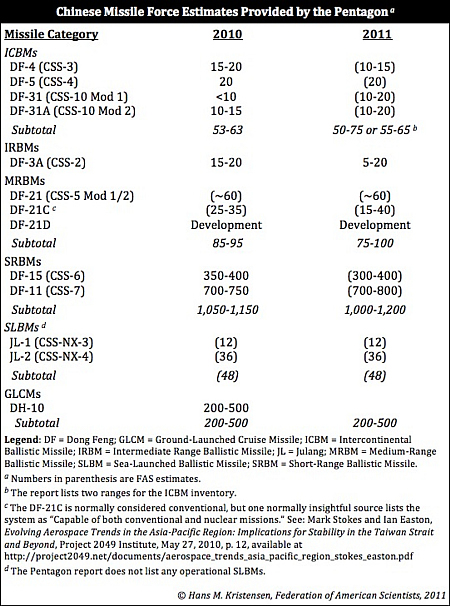 |
| Click on table to download larger version. |
.
Ballistic Missile Submarines
The new Jin-class (Type 094) SSBN appears ready but the Pentagon report states that its JL-2 SLBM “has faced a number of problems and will likely continue flight tests.” The Pentagon previously estimated that the Jin/JL-2 system would become operational in 2010 but the new report now states that it is “uncertain” when the new system will become fully operational.
The range of the JL-2 SLBM is extended, somewhat, from 7,200+ km in the 2010 report to 7,400 km in the 2011 report. This does not change the fact that a Jin-class SLBM would have to deploy deep into the Sea of Japan for its JL-2 to be able to strike the Continental United States. Alaska is within range from Chinese waters, but not Hawaii.
The operational status of the old Xia-class (Type 092) SSBN and its JL-1 SLBM “remain questionable.” Neither class has conducted any deterrent patrols yet.
As a result, China does not appear to have any operational sea-launched ballistic missiles at this point.
The report lists only five nuclear attack submarines with the three fleets, down from six last year, suggesting that retirement of the Han-class (Type 091) continues. The Shang-class (Type 093) is operational, and the Pentagon report states that “as many as five third-generation Type 095 SSNs will be added in the coming years.” The U.S. Navy’s intelligence branch estimated in 2009 that the Type 095 will be noisier than the Russian Akula I but quieter than the Victor III.
Chinese attack submarines conducted 12 patrols during all of 2010, the same level as the previous two years.
Underground Facilities
While there has recently been some sensational reporting (see also here) that China since 1995 has built a 5,000-km “great wall” of tunnels under Hebei mountain in the western parts of the Shaanxi province to hide “all of their missiles hundreds of meters underground,” including the DF-5 (CSS-4) ICBM, the reality is probably a little different.
First, as anyone who has spent just a few hours studying satellite images of Chinese military facilities and monitoring the Chinese internet will know, the Chinese military widely uses underground facilities to hide and protect military forces and munitions. Some of these facilities are also used to hide nuclear weapons. The old DF-4, for example, reportedly has existed in a cave-based rollout posture since the 1970s.
The Pentagon report states that China has “developed and utilized UGFs [underground facilities] since deploying its oldest liquid-fueled missile systems and continue today to utilize them to protect and conceal their newest and most modern solid-fueled mobile missiles.” So it is not new but it is also being used for modern missiles.
| Chinese Underground Missile Launcher Facility |
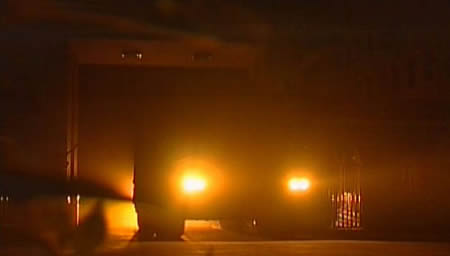 |
| A Chinese mobile missile launcher, possibly for the DF-11 or DF-15 SRBM, emerges from an underground facility at an unknown location. Image: Chinese TV |
.
Second, the particular facility under Hebei mountain appears to be China’s central nuclear weapons storage facility, as recently described by Mark Stokes. The missiles themselves are at the regional bases, although it cannot be ruled out that some may be near Hebei as well. But Stokes estimates that the warheads are concentrated in the central facility with only a small handful of warheads maintained at the six missile bases’ storage regiments for any extended period of time. The missile regiments themselves could also have nearby underground facilities for storing launchers and missiles, although specifics are not known.
One of the Chinese bases with plenty of underground facilities is the large naval base near Yulin on Hainan Island, which I described in 2006 and 2008. The Pentagon report concludes that this base has now been completed and asserts that it is large enough to accommodate a mix of attack and ballistic missile submarines and advanced surface combatants, including aircraft carriers. The report adds that, “submarine tunnel facilities at the base could also enable deployments from this facility with reduced risk of detection.” That would seem to require the submarine exiting from the tunnel submerged; a capability I haven’t seen referenced anywhere yet.
Conclusions
The 2011 Pentagon report shows that China’s nuclear missile force changed little during the past year but appears to continue the slow replacement of old liquid-fueled missiles with new solid-fueled missiles. China’s efforts to develop a sea-launched ballistic missile capability have been delayed.
In an unfortunate change from previous versions of the Pentagon report, the 2011 version significantly reduces the transparency of China’s nuclear missile forces by removing numbers for individual missile types. This change is particularly surprising given the Pentagon’s repeated insistence that China must increase transparency of its military posture. In this case, military secrecy appears to contradict U.S. foreign policy objectives.
The decision to reduce the transparency of China’s missile force is even more troubling because it follows the recent U.S.-Russian decision to significantly curtail the information released to the public under the New START treaty.
The combined effect of these two decisions is that within the past 12 months it has become a great deal harder for the international community to monitor the development of the offensive nuclear missile forces of the United States, Russia and China.
Tell me again whose interest that serves?
See also: 2010 Pentagon Report on China
This publication was made possible by a grant from Carnegie Corporation of New York and Ploughshares Fund. The statements made and views expressed are solely the responsibility of the author.
Panel Discussion at Brookings on NATO Nukes
Steve Pifer was kind enough to invite me to participate in a panel discussion at the Brookings Institution about NATO’s nuclear future and the issue of non-strategic nuclear weapons in the Alliance’s current Defense and Deterrence Posture Review (DDPR).
Steve presented his excellent paper NATO, Nuclear Weapons and Arms Control, Frank Miller, who has been involved in these issue before I could tie my shoe laces, took the “keep US nukes in Europe,” while I argued for the withdrawal of the weapons. Angela Stent moderated the panel.
I’m not yet clear if they’re planning to post a transcript or video, so in the meantime here are my prepared remarks: NATO’s Posture Review and Non-Strategic Nuclear Weapons.
For my writings on this blog about NATO nuclear policy issues, go here.
See also recent letter to NATO Secretary General Ander Fogh Rasmussen coordinated by ACA and and BASIC and signed by two dozen nuclear experts and former senior government officials.
This publication was made possible by a grant from Carnegie Corporation of New York and Ploughshares Fund. The statements made and views expressed are solely the responsibility of the author.
New START Aggregate Numbers Released: First Round Slim Picking
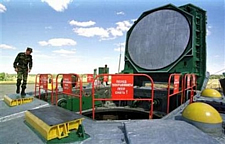 |
| You won’t be able to count SS-18s in the New START aggregate date. |
.
By Hans M. Kristensen
Russia and the United States have released the first Fact Sheet with aggregate numbers for the strategic offensive nuclear forces counted under the New START treaty.
It shows that Russia has already dropped below the New START ceiling of 1,550 accountable deployed warheads and the United States is close behind, seven years before the treaty is scheduled to enter into effect (it makes you wonder what all the ratification delay was about).
But compared with the extensive aggregate numbers that were released during the previous START treaty, the new Fact Sheet is slim picking: just six numbers.
Unless the two countries agree to release more information in the months ahead, this could mark a significant step back in nuclear transparency.
The Aggregate Numbers
The Fact Sheet includes six numbers for three categories of counted U.S. and Russian strategic nuclear arms under the treaty:

United States
The table lists 882 deployed delivery vehicles. Since we know this includes 450 ICBMs and 288 SLBMs, the number of bombers counted appears to be 144. Less than half of those (about 60 B-2 and B-52H) are actually assigned nuclear missions, the balance being “phantom” bombers (B-52H and B-1B) that have some equipment installed that makes them accountable under the treaty.
The 1,800 deployed warheads include approximately 500 on 450 ICBMs and approximately 1,152 on 288 SLBMs. The remaining 148 warheads constitute the remaining “fake” count of one weapon per deployed bomber. That means our estimate was only four warheads off (!).
If subtracting the 144 “fake” bomber weapons, the actual number of U.S. deployed strategic warheads on ICBMs and SLBMs is 1,656, only about 100 warheads from the New START ceiling. The actual number of bomber weapons present at the bases, we estimate, is 300 or less. They are not deployed on the bombers, so they are not counted by New START, but they were counted by the United States during the now-expired Moscow Treaty (SORT). So the real number of operationally available warheads may be around 1,950, which is what we estimated in March.
Another 2,290 non-deployed strategic warheads are in reserve and there are about 760 non-strategic warheads for a total stockpile of approximately 5,000 warheads. Another 3,500 or so warheads are awaiting dismantlement for a total inventory of roughly 8,500 warheads.
The total number of 1,124 deployed and non-deployed missiles and bombers shows that there are 242 non-deployed missiles and bombers. That number includes 48 SLBMs for two non-deployed SSBNs and additional test SLBMs, reserve Minuteman ICBMs and 50 retired Peacekeeper ICBMs, and heavy bombers in overhaul.
The United States has declassified considerable information in the past and hopefully will continue to do so in the future, so the limited aggregate numbers has fewer implications than in the case of Russia. But it would help to see a breakdown of bombers and non-deployed missiles.
Russian Federation
The effect of the limited aggregate numbers has a much more significant effect on the ability to understand the Russian nuclear posture. Most important is the absence of a breakdown of strategic delivery vehicles.
The number of deployed delivery vehicles is listed as 521. The final aggregate number from the expired START treaty was 630 as of July 1, 2009. Not surprisingly, a reduction because the SS-18, SS-19, SS-25 and SS-N-18 are being phased out. But the limited aggregate information makes it impossible to see which missiles have been reduced.
In our latest estimate we counted 534 deployed delivery vehicles, or 13 more than the New START data. The difference may reflect that some SLBMs on Delta IV SSBNs were not fully deployed and a slightly different composition of the ICBM force.
The Fact Sheet lists 1,537 deployed warheads, which actually translates into 1,461 warheads because 76 of them are “fake” bomber weapons. That means Russia has already met the warhead limit of New START – seven years before the treaty enters into effect.
Despite the uncertainty about the force structure, our latest estimate of Russian strategic nuclear warheads deployed on ICBMs and SLBMs was only 122 warheads off.
The aggregate deployed warhead number also more or less confirms long-held suspicion that Russia normally loads its missiles with their maximum capacity of warheads, in contrast to the United States practice of loading only a portion of the warheads.
That means that Russia only has comparatively few strategic warheads in reserve (essentially all bomber weapons). New START does not count such warheads, nor does it count 3,700-5,400 non-strategic warheads in storage or some 3,200 warheads awaiting dismantlement, for a total inventory of up to 11,000 warheads.
The total aggregate number for deployed and non-deployed delivery vehicles is listed as 865. That shows us that Russia has 344 non-deployed delivery vehicles, a considerable amount given the relatively limited size of their deployed force of 521 delivery vehicles. Since Russia has a limited number of bombers more or less exclusively committed to the nuclear mission, the non-deployed delivery vehicles mainly include retired ICBMs. It would be good to hear whether they will be destroyed or stored.
Additional releases
Each of the two parties to New START can decide under the treaty to release additional information to the public about their own nuclear postures. Given the limited information in the aggregate numbers Fact Sheet, it would be a huge disappoint if they don’t.
I understand from the U.S. government that it is planning to do so later this year, and it is important that Russia considers doing so as well.
Under the terms of the treaty the two parties may also agree to jointly release additional information.
Implications
At a first glance the aggregate numbers released by the United States and Russia under the New START treaty is a huge disappointment. It represents a step back in nuclear transparency compared with the standard set by the same two countries under the previous START treaty.
Earlier last month, Ambassador Linton Brooks, Ambassador Jack Matlock and Secretary William Perry joined FAS in calling on the United States and Russia to continue to meet this standard.
We have yet to receive a formal reply but the aggregate numbers Fact Sheet is a reply of sort.
It ought to be a natural that international nuclear transparency is increased with each new treaty, that previously unaccounted categories are brought under accounting, and that uncertainties are cleared up. Moreover, international nuclear transparency means transparency not just for the two parties to the treaty but for the international community as well.
The aggregate numbers Fact Sheet includes the total number of warheads actually deployed on ICBMs and SLBMs, an important improvement from the previous treaty. But the breakdown of number of delivery vehicles and deployment locations has moved into the black.
As mentioned above, the United States and Russia have the right under the treaty – individually or jointly – to release additional information about their nuclear force structures.
It is essential that they do so and continue to do so with each future aggregate numbers Fact Sheet release. Otherwise, the uncertainty about their forces could accumulate and undermine predictability and transparency for other nuclear powers. That, in turn, could make it harder to get those countries involved in nuclear arms control in the future.
This publication was made possible by a grant from Carnegie Corporation of New York and Ploughshares Fund. The statements made and views expressed are solely the responsibility of the author.
Letter Urges Release of New START Data
 |
| Ambassador Brooks, Secretary Perry and Ambassador Matlock join FAS in call for continuing nuclear transparency under New START treaty |
.By Hans M. Kristensen,
Three former U.S. officials have joined FAS in urging the United States and Russia to continue to declassify the same degree of information about their strategic nuclear forces under the New START treaty as they did during the now-expired START treaty.
The three former officials are: Linton Brooks, former chief U.S. START negotiator and administrator of the National Nuclear Security Administration, Jack Matlock, former U.S. ambassador to the Soviet Union and Special Assistant to President Ronald Reagan for national security affairs, and William Perry, former U.S. Secretary of Defense.
At issue is whether the United States and Russia will continue under the New START treaty to release to the public detailed lists – known as aggregate data – of their strategic nuclear forces with the same degree of transparency as they used to do under the now-expired START treaty. There has been concern that the two countries might reduce the information to only include numbers of delivery systems but withhold information about warhead numbers and locations.
In a joint letter, the three former officials joined FAS President Charles Ferguson and myself in urging the United States and Russia to “continue under the New START treaty the practice from the expired START treaty of releasing to the public aggregate numbers of delivery vehicles and warheads and locations.” This practice contributed greatly to international nuclear transparency, predictability, reassurance, and helped counter rumors and distrust, the letter concludes.
Both governments have stated their intention to seek to broaden the nuclear arms control process in the future to include other nuclear weapon states and the letter warns that achieving this will be a lot harder if the two largest nuclear weapon states were to decide to decrease transparency of their nuclear forces under New START.
“Any decrease in public release of information compared with START would be a step back.”
The letter was sent to Rose Gottemoeller, the U.S. Assistant Secretary of State for Arms Control, Verification and Compliance, and Sergey Kislyak, the Ambassador of the Russian Federation to the United States.
This publication was made possible by a grant from Carnegie Corporation of New York and Ploughshares Fund. The statements made and views expressed are solely the responsibility of the author.
New START Data Exchange: Will it Increase or Decrease International Nuclear Transparency?
 |
| U.S. officials say that aggregate numbers of the New START treaty will be made publicly available but that these may be very general numbers and a decision still has to be made. For a copy of the final START aggregate numbers, click here. |
.
By Hans M. Kristensen
The first data exchange of the New START treaty between the United States and Russia has taken place, according to a report by RIA Novosti.
This is the first of more than 20 such data exchanges planned under the treaty for the next 10 years where Russia and the United States twice a year will send each other a list showing how many long-range ballistic missiles and heavy bombers they have and how many nuclear weapons they carry.
But while the exchanges will increase U.S-Russia nuclear transparency, the rest of the world may be facing a future with less information about U.S. and Russian strategic nuclear forces than in the past.
“All exchanges are classified and will not be subject to release,” a U.S. official told me. “There may be some information on very general numbers under the Treaty that could be made public, but that is still to be determined, and will not occur for a least six months if it occurs at all.”
Previous Nuclear Transparency
During the previous START treaty regime between 1994 and 2009, the two countries also exchanged data. That data was classified but the two sides released so-called aggregate numbers biannually to the public (the final START release is here]. Rose Gottemoeller, the U.S. Assistant Secretary for the Bureau of Arms Control, Verification and Compliance, assured early on that “data on the aggregate number of warheads each Party deploys on ICBMs and SLBMs will be exchanged and made publicly available” for New START as well. (Emphasis added)
Hopefully that will happen, but the aggregate numbers release was based on a much larger document – the Memorandum of Understanding (MOU) – exchanged between the two countries twice a year. The unclassified MOU was not published because (I was told) of Russian objections, but the United States would – upon request – release the MOU, which provided much more detailed data for each nuclear weapon and facility.
| START July 2009 Memorandum of Understanding |
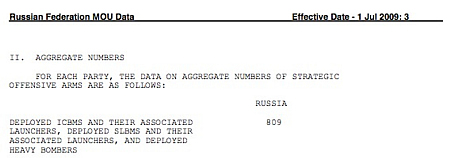 |
| The first START treaty provided the public with detailed overviews of U.S. and Russian strategic nuclear forces. Will New START do so as well or decrease international nuclear transparency? To down copy of the final START MOU, click here. |
.
The MOU provided important information for the international community to monitor the development of U.S. and Russian long-range nuclear forces. But the official statements made so far suggest that such detailed information might not be released under New START.
Implications and Recommendations
The New START treaty is widely seen as a first step in a process that seeks to involve other nuclear weapon states in future nuclear arms control negotiations. As such, it is important that the United States and Russia continue to make detailed information on the status of their nuclear forces available to the international community.
At the very least, this should include the aggregate numbers – including breakdown by individual nuclear weapon systems. But it should also continue the practice of releasing the full unclassified MOUs to increase international transparency and predictability in nuclear forces. Doing anything else would be a step back that could create mistrust and undercut a broadening of the nuclear arms control progress to other nuclear weapon states.
Each new step in the arms control process must increase transparency, not reduce it.
This publication was made possible by a grant from Carnegie Corporation of New York and Ploughshares Fund. The statements made and views expressed are solely the responsibility of the author.
Talk at Georgetown U Event on Tac Nuke Treaty
By Hans M. Kristensen
The Center on National Security and the Law and the Federal Legislation and Administrative Clinic co-hosted an event at Georgetown University Law Center on Tuesday, March 1st: Next Steps after New START: A Treaty on Tactical Nuclear Weapons.
The event included a keynote speech by Edward Warner, the Senior Advisor to the under Secretary of Defense for Policy.
I gave a briefing on the status of US and Russian nonstrategic nuclear weapons. Other panelists included Michael May, former director of Lawrence Livermore National Laboratory and now at Stanford University, Paul Dean from the Department of State, Madelyn Creedon with the Senate Armed Services Committee, and Tim Morrison from the office of Senator Jon Kyl. Dakota Rudesill from the Law Center moderated.
This publication was made possible by a grant from Carnegie Corporation of New York and Ploughshares Fund. The statements made and views expressed are solely the responsibility of the author.
Documents Obtained by FAS Shed New Light on US Arms Transfers
by Matt Schroeder
The Federation of American Scientists has acquired two previously unreleased US government reports on arms transfers, one on recent sales of US weapons and the other on arms purchased for the Afghanistan government with US military aid. Both documents were acquired under the Freedom of Information Act.
The first report, which is often referred to as the Section 36(a) report after the section in the Arms Export Control Act that requires it, contains data on, inter alia, Foreign Military Sales, transfers of Excess Defense Articles, grants and loans through the Foreign Military Financing Program, projected arms sales, Foreign Military Construction Sales, and Security Assistance Surveys (including end-use monitoring). The report contains detailed data on transfers of Major Defense Equipment in 2009 and the total value of arms transfers by country in the first quarter of Fiscal Year 2010 (1 October – 31 December 2009). Given recent unrest in the Middle East, data on recent or pending arms sales to Bahrain, Egypt, and Yemen is likely to be of particular interest.
The other document acquired by the FAS is a lengthy (137 page) list of arms procured through the Defense Department’s Afghanistan Security Forces Fund (ASFF). The millions of items listed in the report range from “drugs and surgical dressings” to M24 sniper rifles to Russian cargo aircraft. Given that many of these purchases are not recorded in the main annual reports on US arms sales, this document may be the most complete (consolidated) source of data on items acquired through the ASFF.
